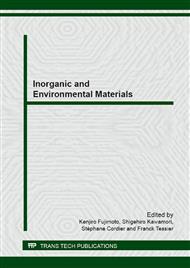p.209
p.213
p.217
p.221
p.225
p.229
p.233
p.237
p.243
Reactivity of Carbonates in Superheated Steam under Atmospheric Pressure
Abstract:
The effect of superheated steam on the decomposition of CaCO3 and MnCO3 and on the solid state reactions of ZnCO3-FeOOH and MnCO3-CaCO3 was investigated. A newly developed apparatus for the experiments under 1 atm of pure water vapor was used. CaCO3 decomposed at 800 oC in the superheated steam to form the single phase of CaO. On the other hand, the decomposition was uncompleted in air. CaCO3 transformed into CaO via Ca (OH)2 in superheated steam. During the transformation of carbonate into hydroxide, the crystal lattice is temporarily disordered to make it active, leading lower decomposition temperature of CaCO3. MnCO3 decomposed to form γ-Mn2O3 at above 1000 oC in air, whereas γ-Mn2O3 was obtained at 800 oC in the superheated steam. The solid state reaction in the steam was suppressed for the mixture of ZnCO3 and FeOOH. This seemed to be due to the large difference in decomposition temperature between ZnCO3 and FeOOH. MnCO3 reacted with CaCO3 to form CaMn2O4 at 800 oC in the superheated steam. However, a higher temperature of 1000 oC was required to cause the reaction in air. The low-temperature transformation of MnCO3 and CaCO3 in the superheated steam would affect the reaction. It was concluded that the reactivity of carbonate in super heated steam was promoted by the Hedvall effect, which was caused by the formation of intermediate phase such as hydroxide.
Info:
Periodical:
Pages:
225-228
Citation:
Online since:
June 2014
Authors:
Keywords:
Price:
Сopyright:
© 2014 Trans Tech Publications Ltd. All Rights Reserved
Share:
Citation:


